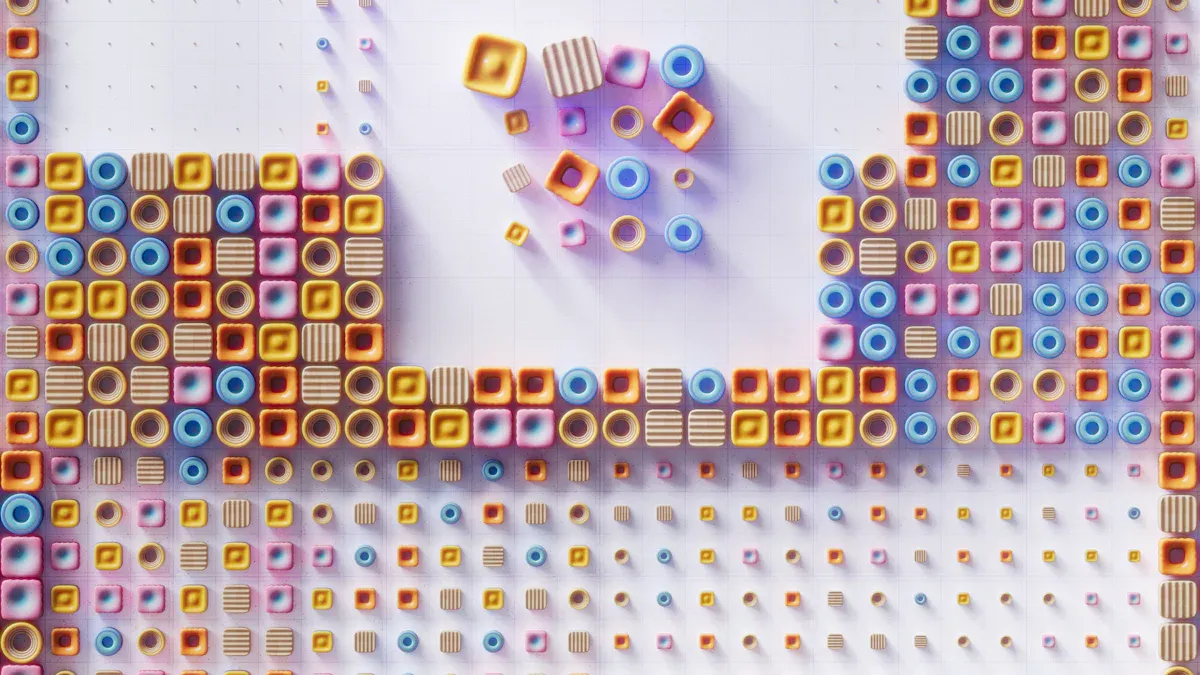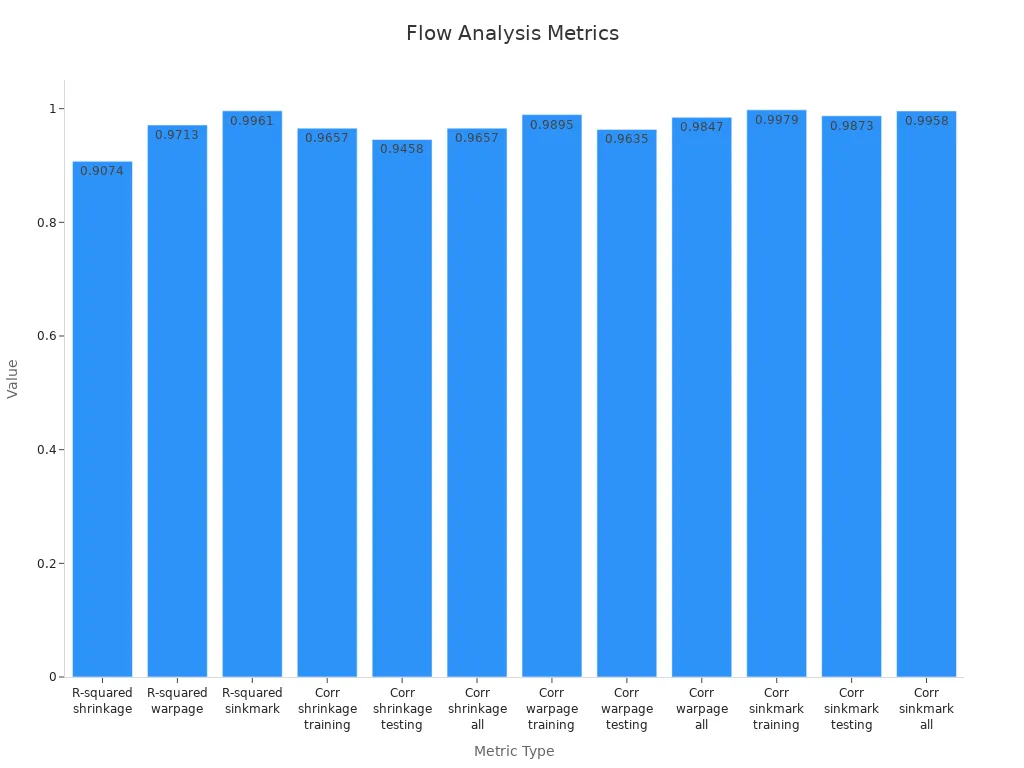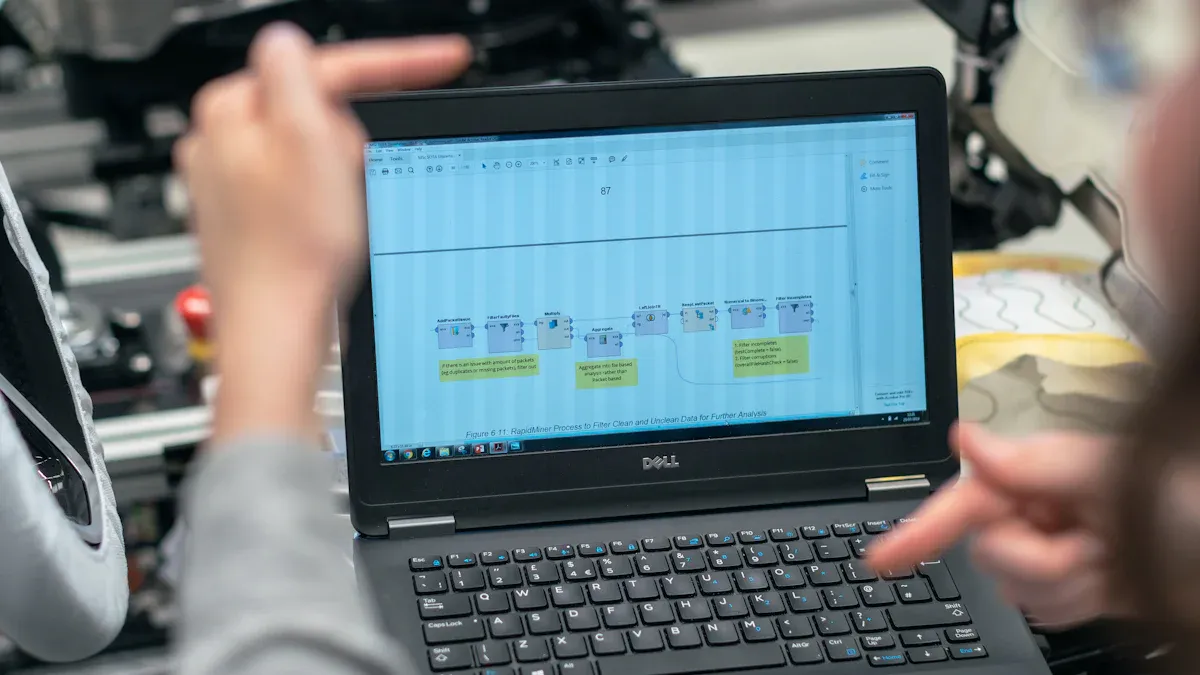
Mold flow analysis is a simulation tool that predicts how molten material behaves during the injection molding process. It helps you visualize material flow, filling patterns, and cooling behavior. This insight ensures precision in complex mold designs by identifying potential issues before production begins.
You can improve product quality and reduce defects like sink marks or voids by managing critical parameters such as temperature and injection speed. Mold flow analysis also optimizes your production cycle, cutting time by 10–30% and saving costs. Its predictive capabilities enhance both efficiency and material usage, making it indispensable for modern manufacturing.

Mold flow analysis is a powerful simulation tool used in the injection molding process. It predicts how molten plastic flows into a mold, cools, and solidifies. This analysis helps you identify potential defects and optimize designs before production begins. By using mold flow analysis, you can ensure high-quality parts, reduce costs, and improve manufacturing efficiency.
Mold flow analysis works by simulating the injection molding process. It uses advanced software to model the flow of molten material into a mold cavity. The simulation evaluates critical stages, including filling, packing, cooling, and warping. Each stage provides valuable insights into how the material behaves under specific conditions.
For example, filling analysis focuses on how the molten plastic fills the mold. It identifies areas where the material might not flow evenly, leading to defects like air pockets or weld lines. Warpage analysis examines how the part might deform as it cools, ensuring dimensional accuracy. These simulations rely on physical principles such as fluid dynamics and heat transfer to deliver precise results.
Tip: Use mold flow analysis early in the design process to predict and prevent issues like warping or uneven cooling. This proactive approach saves time and resources.
Injection mold flow analysis offers several measurable features that enhance the manufacturing process. These features ensure that your parts meet high standards of quality and performance. Here’s a breakdown of the key features:
| Feature | Description |
|---|---|
| Consistent Material Flow | Ensures even filling of the mold, crucial for strength and durability of parts. |
| Dimensional Accuracy | Achieves tight tolerances (±0.05 mm) for parts that must fit together perfectly. |
| Surface Finish | Meets high SPI standards for aesthetic appeal and durability, especially in visible parts. |
| Parting Line Precision | Influences the overall appearance and functionality of products, critical for high-precision parts. |
These features make injection mold flow analysis an essential tool for achieving precision and efficiency in manufacturing.
In modern mold design, mold flow analysis plays a vital role. It allows you to refine part and mold designs, ensuring optimal performance and minimal defects. For instance, filling analysis helps you predict surface quality issues like sink marks or weld lines. Warpage analysis ensures that parts maintain their shape and dimensions after cooling.
Additionally, mold flow analysis supports material selection by identifying materials that flow optimally and meet performance requirements. It also aids in designing efficient cooling systems, which reduce cycle times and improve product quality. According to industry experts, using mold flow analysis early in the design process leads to cost-effective tool development and faster production timelines.
Note: Mold flow analysis is not just a tool; it’s a strategy for achieving better results in injection molding. By integrating it into your workflow, you can stay ahead in today’s competitive manufacturing landscape.
Mold flow analysis helps you refine both mold and part designs by predicting how materials behave during the injection process. This simulation identifies potential issues like air traps, weld lines, and warpage before production begins. By addressing these problems early, you can create designs that ensure better performance and higher-quality parts.
For example, numerical simulations of the mold filling process validate experimental results. These simulations highlight how geometric variations affect flow resistance and filling conditions. Using this data during the design phase allows you to make necessary adjustments, ensuring optimal outcomes.
Case Study Insight: Numerical filling studies conducted during early product development stages have shown significant improvements in part quality. These studies emphasize the importance of addressing design issues early to avoid costly errors later.
A statistical analysis further confirms the benefits of mold flow analysis in optimizing designs:
| Benefit | Description |
|---|---|
| Predictive Insights | Provides critical insights into material behavior during injection molding. |
| Design Optimization | Helps avoid defects like air traps and warpage, leading to better designs. |
| Cost Reduction | Identifies issues early, reducing material waste and production costs. |
| Risk Mitigation | Reduces design-related risks by enabling adjustments before tool fabrication. |
Choosing the right material is crucial for manufacturing complex injection molded parts. Mold flow analysis simplifies this process by evaluating how different materials perform during molding. It assesses factors like flow characteristics, shrinkage rates, and mechanical properties, helping you select materials that balance functionality and manufacturability.
Key insights from mold flow analysis reports include:
- Evaluating melt flow index and viscosity to ensure smooth material flow.
- Analyzing cooling characteristics to minimize cycle times.
- Assessing material behavior to reduce defects like sink marks and warpage.
By leveraging these insights, you can confidently choose materials that meet your design and production requirements. This approach not only improves part quality but also enhances overall efficiency.
Defects like shrinkage, warpage, and sink marks can compromise the quality of an injection molded part. Mold flow analysis minimizes these issues by simulating the entire molding process. It predicts how materials will behave under specific conditions, allowing you to make adjustments that reduce defects.
Quantitative data highlights the effectiveness of mold flow analysis in defect reduction:
| Metric | Value |
|---|---|
| R-squared (shrinkage) | 0.9074 |
| R-squared (warpage) | 0.9713 |
| R-squared (sinkmark) | 0.9961 |
| Reduction in shrinkage | 37.8% |
| Reduction in warpage | 53.9% |

These metrics demonstrate how mold flow analysis improves part quality by addressing defects at their root cause. By integrating this tool into your workflow, you can achieve consistent results and reduce production waste.

The placement of the gate in an injection mold significantly impacts the quality and efficiency of the molding process. By using mold flow analysis, you can determine the optimal gate location to ensure balanced material flow and reduce defects. For example, a well-placed gate minimizes issues like air traps and weld lines, which can compromise part quality.
Studies have shown that gate location directly affects product performance and cycle time. A simulation comparing center and edge gate placements revealed that a central gate improves filling balance and cooling quality. Another study highlighted that optimizing gate location reduces material waste and enhances dimensional accuracy. The table below summarizes these findings:
| Study Title | Key Findings | Methodology |
|---|---|---|
| A study of gate location optimization of plastic injection molding using sequential linear programming | Gate location significantly affects product quality and cycle time. | Simulation software analyzed different gate locations and their impact. |
| Filling balance optimization by best gate location | Optimal gate location maximizes melt flow balance, improving part quality. | Non-linear optimization algorithm applied through Moldflow Plastics Insight. |
| Computer Simulation for Finding Optimum Gate Location in Plastic Injection Moulding Process | Optimized gate location reduces defects and material waste. | Plastic advisor simulation tool used for analysis. |
| Multi-Objective Optimization of Gate Location and Processing Conditions in Injection Molding Using MOEAs | Gate location is crucial for dimensional accuracy and balanced filling patterns. | Multi-objective Evolutionary Algorithm integrated with CAE software. |
By leveraging mold flow analysis, you can achieve precise gate placement, leading to better part quality and reduced production costs.
Cycle time is a critical measure of production efficiency in injection molding. Mold flow analysis helps you identify areas where time can be saved, such as during the filling and cooling stages. By optimizing injection speed and material flow, you can reduce the time it takes to fill the mold by up to 1.2 seconds. Over thousands of cycles, this translates into significant time savings.
You can also analyze cycle time components to implement multiple improvement projects simultaneously. For instance, adjusting cooling system parameters and refining gate placement can work together to shorten the overall cycle. These improvements not only enhance efficiency but also lower production costs.
Tip: Use mold flow analysis to evaluate cycle time early in the design phase. This proactive approach ensures smoother production and faster turnaround times.
Efficient cooling systems are essential for maintaining part quality and reducing cycle times. Mold flow analysis allows you to design cooling channels that evenly distribute heat, preventing defects like warpage and sink marks. By simulating the cooling process, you can identify hotspots and adjust the cooling layout to achieve uniform temperature distribution.
For example, mold flow analysis can help you determine the optimal placement of cooling channels to minimize cooling time. This reduces the overall cycle time and ensures consistent part quality. Additionally, efficient cooling systems lower energy consumption, making your production process more sustainable.
By improving cooling system efficiency, you can enhance both the quality and cost-effectiveness of your injection molding operations.
Mold flow analysis helps you reduce material waste by ensuring precise material usage during the injection process. By simulating the flow of molten material, you can predict and prevent issues like overpacking or uneven filling. This reduces the likelihood of defects, which often lead to scrapped parts and wasted resources.
Precise material characterization plays a key role in this process. It minimizes errors and ensures that the right amount of material is used for each part. This not only saves costs but also supports sustainable manufacturing practices by reducing waste. When you integrate mold flow analysis into your workflow, you can achieve both economic and environmental benefits.
Traditional mold development often involves a trial-and-error approach, which can be time-consuming and costly. Mold flow analysis eliminates much of this guesswork by providing accurate simulations of the molding process. These simulations allow you to identify potential issues, such as warpage or air traps, before creating physical molds.
Key advancements in simulation tools have transformed mold development practices:
- Molding simulations significantly reduce the time and costs associated with trial-and-error.
- Tools like Moldex3D enable early detection of potential problems, ensuring smoother production.
- The Design of Experiments (DOE) method helps you avoid unnecessary molding issues, streamlining the development process.
By relying on these tools, you can create better molds faster and with fewer iterations, saving both time and money.
Mold flow analysis accelerates your product's time-to-market by enabling rapid prototyping and design modifications. Quick Turn Molding solutions, for instance, allow you to test and refine designs in weeks rather than months. This shortens feedback loops and helps you respond to customer demands more quickly.
AI-enhanced workflows further speed up the process. Traditional design cycles often take 4–6 weeks for iterations, but AI-assisted simulations can reduce this timeline to just 2–3 weeks. This faster turnaround gives you a competitive edge by allowing you to launch products sooner and adapt to market changes effectively.
By integrating mold flow analysis into your design process, you can achieve faster production timelines, reduce costs, and improve overall efficiency.
Choosing the right mold flow analysis software is essential for achieving accurate results. You should evaluate software based on its features and how well it aligns with your project needs. Some platforms excel in handling complex geometries, while others offer advanced visualization tools. Comparing key features can help you make an informed decision:
| Feature | Description |
|---|---|
| Meshing Capabilities | Ability to generate high-quality meshes for complex geometries, either manually or automatically. |
| Material Databases | Access to physical and thermal properties of materials, with options to add custom materials. |
| Analysis Modes | Multiple modes such as fill, pack, cool, warp, shrinkage, and stress analysis available. |
| Visualization Options | Clear output in 2D or 3D formats, with customizable charts and animations. |
| Optimization Functionalities | Tools to find optimal design and process variables for improved performance. |
When selecting software, prioritize tools that offer flexibility and comprehensive analysis modes. This ensures you can address various challenges during the injection molding process.
Working with mold design experts can significantly enhance your results. These professionals bring valuable experience and insights that complement mold flow analysis. They can help you interpret simulation data and suggest practical improvements to your designs. For example, experts might recommend adjustments to gate placement or cooling channels to optimize performance.
Collaboration also fosters innovation. By combining your knowledge of the product with their expertise in mold design, you can create solutions that are both efficient and cost-effective. Regular communication ensures that everyone stays aligned, reducing the risk of errors during production.
Keeping your simulation parameters up to date is crucial for accurate results. Material properties, machine settings, and environmental conditions can change over time. If you don’t update these parameters, your simulations may not reflect real-world conditions.
You should review and adjust parameters before running new simulations. For instance, updating the material database ensures that the software uses the latest data for flow and cooling behavior. Regular updates improve the reliability of your analysis and help you maintain high-quality production standards.
Tip: Set a schedule to review and update simulation parameters periodically. This proactive approach saves time and prevents costly mistakes.
Mold flow analysis plays a crucial role in achieving precision and efficiency in injection molding. It reduces defects, optimizes designs, and enhances production outcomes. For example, integrating this tool can lower cycle times by 10–30%, improve product quality, and significantly increase annual profits.
By adopting mold flow analysis, you can streamline your design process and reduce costs. Its predictive capabilities help you avoid errors and create high-quality parts faster. Incorporating this tool into your workflow ensures better results and keeps you competitive in manufacturing.
You should use mold flow analysis early in the design phase. It helps you identify potential issues like warpage or uneven cooling before production begins. Early analysis saves time and reduces costs.
Yes, mold flow analysis supports a wide range of materials. You can evaluate plastics, metals, and composites. Use the software’s material database to check flow properties and cooling behavior for your chosen material.
Simulations are highly accurate when you input correct parameters. Update material properties, machine settings, and environmental conditions regularly. This ensures the analysis reflects real-world conditions and delivers reliable results.
Basic training helps you understand the software’s features. Many platforms offer tutorials and user guides. Collaborating with mold design experts can also improve your understanding and results.
Absolutely! Mold flow analysis minimizes defects, reduces material waste, and shortens cycle times. These improvements lower production costs and increase efficiency, making it a cost-effective tool for manufacturers.